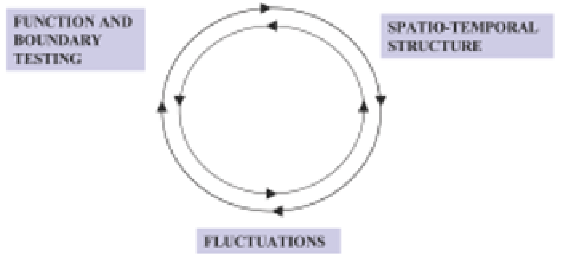Information Technology Reference
In-Depth Information
However, the theory of dissipative structure has the potential to be applied to systems
beyond those of concern to natural science (Nicolis and Prigogine, 1977; Jantsch, 1980;
Prigogine and Stengers, 1984). In this theory, fluctuations play a vital role in causing
significant system change because, when a system is driven to a critical instability point
(bifurcation point or point of singularity), the non-equilibrium system can be regarded
as testing various configurations by fluctuations, which results in a new space and time
structure (Haken, 1984, 1987). In other words fluctuations, which lead to instabilities,
may be introduced to the system in order to yield new types of function and structure.
In this sense, no system is structurally stable. Rather, the evolution of dissipative
structure is a self-determining sequence of its function and boundary testing, spatio-
temporal structure, and fluctuations (Nicolis and Prigogine, 1977; Allen, 1981) as illus-
trated in Figure 11.5.
Figure 11.5. The role of fluctuations in creating order.
In addition, the source of fluctuations can be internal or external (Allen, 1981). In organ-
isations, sources of internal fluctuations may come from the action of leaders or managers
or the dynamic of power and political struggle and activities. External sources may arise
from both the macro-environment (i.e. economic, technological, political, and socio-
cultural) and the micro-environment (i.e. customers, suppliers, competitors, etc.).
Figure 11.6 shows how macroscopic order can be created through fluctuations and how
it is related to the system's ability to cope with complexity and environmental contin-
gencies. At
α
1
an organisation, as a complex system, has a capacity to cope with complex-
ity at level L
1
, within a range of environmental contingencies R
1
. As the environmental
contingencies increase, the system can still maintain a steady state, a state within which
negative feedback operates. This is represented by the straight-line portion of the graph
within range R
1
. However, as the environmental contingencies keep on increasing, the
system starts to destabilise and fluctuations start to occur. If fluctuations are accentuated,
this is because positive feedback is now dominating in the system. This process will
continue until it reaches a bifurcation point (or point of singularity), where the system
either self-organises and transforms (evolves) into a new form (i.e. new spatio-temporal
structure), which is more complex and more capable of coping with the new level of
complexity (a state of
α
2
at level L
2
) and the next range of increased environmental
contingencies R
2
, or it deteriorates and runs down because it fails to self-organise. This
process will continue as long as the system succeeds in self-organising itself to handle
the increase in environmental contingencies (i.e. it can achieve a state of
α
2
,
α
3
, …).

Search WWH ::

Custom Search